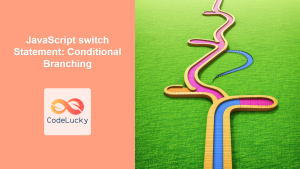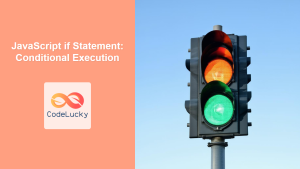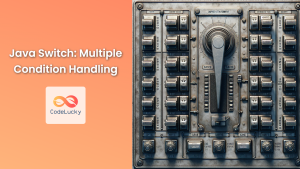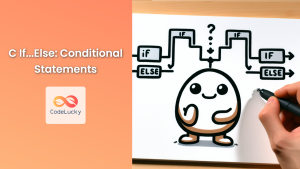JavaScript, a versatile and powerful programming language, offers developers various tools to control the flow of their code. One such tool is the switch statement, a robust alternative to multiple if...else conditions. This article delves deep into the intricacies of the switch statement, exploring its syntax, use cases, and best practices.
Understanding the Switch Statement
The switch statement is a control flow statement that allows you to execute different blocks of code based on different conditions. It's particularly useful when you need to compare a single value against multiple possible matches.
Basic Syntax
Let's start with the basic syntax of a switch statement:
switch (expression) {
case value1:
// Code to be executed if expression === value1
break;
case value2:
// Code to be executed if expression === value2
break;
// More cases...
default:
// Code to be executed if expression doesn't match any case
}
Here's what each part does:
expression: This is the value you want to compare against the cases.case: Each case represents a possible value of the expression.break: This keyword prevents the code from running into the next case.default: This is optional and runs if no case matches the expression.
Let's see this in action with a simple example:
let day = 3;
let dayName;
switch (day) {
case 1:
dayName = "Monday";
break;
case 2:
dayName = "Tuesday";
break;
case 3:
dayName = "Wednesday";
break;
case 4:
dayName = "Thursday";
break;
case 5:
dayName = "Friday";
break;
case 6:
dayName = "Saturday";
break;
case 7:
dayName = "Sunday";
break;
default:
dayName = "Invalid day";
}
console.log(dayName); // Output: Wednesday
In this example, the switch statement checks the value of day and assigns the corresponding day name to dayName.
🚀 Advanced Switch Techniques
Now that we've covered the basics, let's explore some more advanced techniques and use cases for the switch statement.
Multiple Cases for One Action
Sometimes, you might want to execute the same code for multiple cases. You can do this by stacking case statements:
let fruit = "apple";
let fruitType;
switch (fruit) {
case "apple":
case "pear":
case "cherry":
fruitType = "pome fruit";
break;
case "peach":
case "plum":
case "apricot":
fruitType = "stone fruit";
break;
default:
fruitType = "unknown fruit type";
}
console.log(fruitType); // Output: pome fruit
In this example, "apple", "pear", and "cherry" all result in "pome fruit", while "peach", "plum", and "apricot" result in "stone fruit".
Switch with Ranges
While switch statements typically work with discrete values, you can use them with ranges by leveraging the fact that case statements can be any expression that evaluates to true or false:
let score = 85;
let grade;
switch (true) {
case score >= 90:
grade = "A";
break;
case score >= 80:
grade = "B";
break;
case score >= 70:
grade = "C";
break;
case score >= 60:
grade = "D";
break;
default:
grade = "F";
}
console.log(grade); // Output: B
This technique allows you to use switch statements in situations where you might typically use if...else statements.
Switch with Method Calls
You can also use method calls in your case statements, which can be useful for more complex comparisons:
let fruit = "apple";
let fruitCategory;
switch (fruit.toLowerCase()) {
case "apple":
case "pear":
case "cherry":
fruitCategory = "pome";
break;
case "peach":
case "plum":
case "apricot":
fruitCategory = "stone";
break;
case fruit.includes("berry"):
fruitCategory = "berry";
break;
default:
fruitCategory = "unknown";
}
console.log(fruitCategory); // Output: pome
In this example, we use toLowerCase() to make the comparison case-insensitive, and we use includes() to check if the fruit name contains "berry".
🎭 Switch vs. If…Else
While switch and if...else statements can often be used interchangeably, each has its strengths. Let's compare them:
// Using if...else
let day = 3;
let dayName;
if (day === 1) {
dayName = "Monday";
} else if (day === 2) {
dayName = "Tuesday";
} else if (day === 3) {
dayName = "Wednesday";
} else if (day === 4) {
dayName = "Thursday";
} else if (day === 5) {
dayName = "Friday";
} else if (day === 6) {
dayName = "Saturday";
} else if (day === 7) {
dayName = "Sunday";
} else {
dayName = "Invalid day";
}
// Using switch
switch (day) {
case 1:
dayName = "Monday";
break;
case 2:
dayName = "Tuesday";
break;
case 3:
dayName = "Wednesday";
break;
case 4:
dayName = "Thursday";
break;
case 5:
dayName = "Friday";
break;
case 6:
dayName = "Saturday";
break;
case 7:
dayName = "Sunday";
break;
default:
dayName = "Invalid day";
}
The switch statement is often more readable when you're comparing a single variable against many possible values. However, if...else statements are more flexible and can handle more complex conditions.
🛠️ Best Practices and Common Pitfalls
When using switch statements, keep these best practices in mind:
1. Always Use Break Statements
Forgetting to use break statements can lead to unexpected behavior:
let fruit = "apple";
let message = "";
switch (fruit) {
case "apple":
message += "I like apples. ";
case "banana":
message += "I like bananas. ";
case "orange":
message += "I like oranges. ";
default:
message += "I like fruits. ";
}
console.log(message); // Output: I like apples. I like bananas. I like oranges. I like fruits.
Without break statements, the code "falls through" to the next case, executing all subsequent cases. While this can sometimes be useful, it's often unintended and can lead to bugs.
2. Use the Default Case
Always include a default case to handle unexpected inputs:
let color = "purple";
let mood;
switch (color) {
case "red":
mood = "energetic";
break;
case "blue":
mood = "calm";
break;
case "green":
mood = "refreshed";
break;
default:
mood = "neutral";
}
console.log(mood); // Output: neutral
3. Be Mindful of Type Coercion
JavaScript uses strict equality (===) for case matching. This means that the types must match:
let value = "1";
switch (value) {
case 1:
console.log("Number 1");
break;
case "1":
console.log("String 1");
break;
default:
console.log("Neither");
}
// Output: String 1
🚀 Advanced Example: State Machine
Let's wrap up with a more complex example that demonstrates how switch statements can be used to implement a simple state machine:
function processOrder(state, action) {
switch (state) {
case "idle":
switch (action) {
case "place_order":
return "processing";
default:
return state;
}
case "processing":
switch (action) {
case "payment_received":
return "shipped";
case "cancel":
return "cancelled";
default:
return state;
}
case "shipped":
switch (action) {
case "deliver":
return "delivered";
case "return":
return "returned";
default:
return state;
}
case "delivered":
case "cancelled":
case "returned":
return state; // These are final states
default:
throw new Error(`Invalid state: ${state}`);
}
}
let orderState = "idle";
console.log(orderState); // Output: idle
orderState = processOrder(orderState, "place_order");
console.log(orderState); // Output: processing
orderState = processOrder(orderState, "payment_received");
console.log(orderState); // Output: shipped
orderState = processOrder(orderState, "deliver");
console.log(orderState); // Output: delivered
orderState = processOrder(orderState, "return");
console.log(orderState); // Output: delivered (because it's a final state)
This example uses nested switch statements to implement a state machine for an order processing system. It demonstrates how switch statements can be used to handle complex logic in a clear and organized manner.
Conclusion
The switch statement is a powerful tool in JavaScript that allows for clear and concise handling of multiple conditions. While it may seem simple at first glance, it offers a lot of flexibility and can be used in sophisticated ways. By understanding its nuances and best practices, you can write more efficient and readable code.
Remember, the key to mastering switch statements (and JavaScript in general) is practice. Try incorporating these concepts into your own projects, and you'll soon find yourself using switch statements with confidence and creativity.
Happy coding! 🚀👨💻👩💻

















